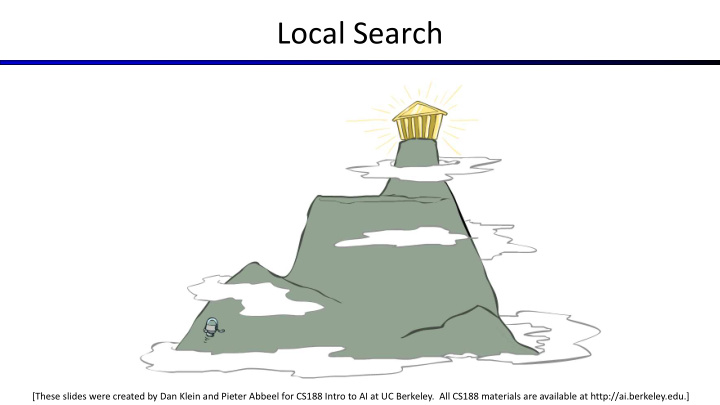



Local Search [These slides were created by Dan Klein and Pieter Abbeel for CS188 Intro to AI at UC Berkeley. All CS188 materials are available at http://ai.berkeley.edu.]
Iterative Improvement
Iterative Algorithms for CSPs Local search methods typically work with “complete” states, i.e., all variables assigned To apply to CSPs: Take an assignment with unsatisfied constraints Operators reassign variable values No fringe! Live on the edge. Algorithm: While not solved, Variable selection: randomly select any conflicted variable Value selection: min-conflicts heuristic: Choose a value that violates the fewest constraints I.e., hill climb with h(n) = total number of violated constraints
Example: 4-Queens States: 4 queens in 4 columns (4 4 = 256 states) Operators: move queen in column Goal test: no attacks Evaluation: c(n) = number of attacks [Demo: n-queens – iterative improvement (L5D1)] [Demo: coloring – iterative improvement]
Performance of Min-Conflicts Given random initial state, can solve n-queens in almost constant time for arbitrary n with high probability (e.g., n = 10,000,000)! The same appears to be true for any randomly-generated CSP except in a narrow range of the ratio
Local Search Tree search keeps unexplored alternatives on the fringe (ensures completeness) Local search: improve a single option until you can’t make it better (no fringe!) New successor function: local changes Generally much faster and more memory efficient (but incomplete and suboptimal)
Hill Climbing Simple, general idea: Start wherever Repeat: move to the best neighboring state If no neighbors better than current, quit What’s bad about this approach? Complete? Optimal? What’s good about it?
Hill Climbing Diagram
Hill Climbing Quiz Starting from X, where do you end up ? Starting from Y, where do you end up ? Starting from Z, where do you end up ?
Simulated Annealing Idea: Escape local maxima by allowing downhill moves But make them rarer as time goes on 10
Simulated Annealing Theoretical guarantee: Stationary distribution: If T decreased slowly enough, will converge to optimal state! Is this an interesting guarantee? Sounds like magic, but reality is reality: The more downhill steps you need to escape a local optimum, the less likely you are to ever make them all in a row People think hard about ridge operators which let you jump around the space in better ways
Genetic Algorithms Genetic algorithms use a natural selection metaphor Keep best N hypotheses at each step (selection) based on a fitness function Also have pairwise crossover operators, with optional mutation to give variety Possibly the most misunderstood, misapplied (and even maligned) technique around
Example: N-Queens Why does crossover make sense here? When wouldn’t it make sense? What would mutation be? What would a good fitness function be?
Recommend
More recommend